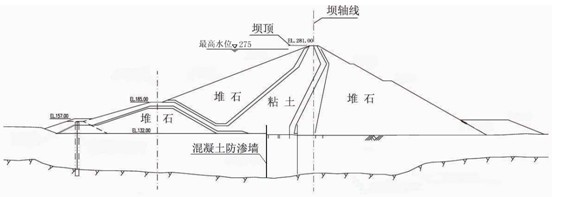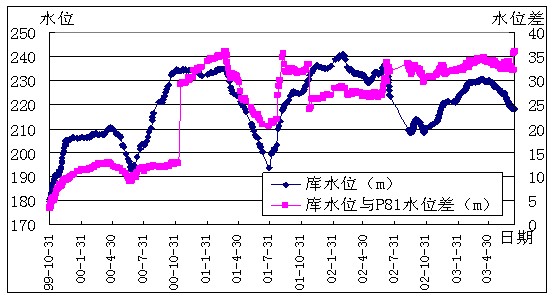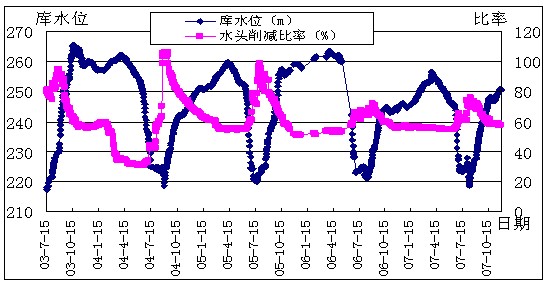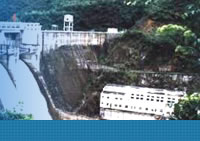By Qu Zhangbin and Xiao Qiang and ShiYueChun
(Yellow River Water and Hydropower Development Co., Ministry of Water Resources,Jiyuan City, Henan Province, P.R.China, 454681)
Abstract: As planned, the final sedimentation accumulated in front of Xiaolangdi Dam would reach more than 120 meters in thickness. In order to put the natural anti-seepage blanket formed by the sedimentation into effective use, the usage of sedimentation blanket to minimize the seepage in the foundation of Dam had been taken into account when designing the dam structure. In this article, by analyzing the surveillance data in 8 years since the operation of Xiaolangdi Reservoir read from piezometers installed in the foundation in front of Dam, it is found that the sedimentation accumulated in front of Dam has consumed more than half of work water head of the Dam, which is worthy of being a reference for the design and operation of similar projects in the future.
Keywords: Sedimentation Accumulation in Reservoir, Foundation Seepage, Xiaolangdi
1. Introduction
Xiaolangdi multipurpose dam project is a clay sloping core rock-fill dam, with the maximum dam height at 160m. The one of major purposes of building Xiaolangdi Reservoir is to minimize sedimentation, i.e. to mitigate the sediment accumulated in downstream river course. According to the design, the final sedimentation accumulated in front of Xiaolangdi Dam will be more than 120m thick. After the water storage of the reservoir started, it was monitored that the medium diameter of sediment deposited in front of dam was about 0.005mm, which is fine-silty sand, a kind of favorable natural anti-seepage soil material. The foundation of Xiaolangdi Dam at the riverbed part is a 70m-deep blanket layer. In order to put the natural anti-seepage blanket formed by the sedimentation in front of dam into effective use, the usage of sedimentation blanket to minimize the seepage in the foundation of Dam had been taken into account when designing the dam structure. The typical profile of Dam can be seen in Illustration 1 as below:

Illustration 1: Typical Profile of Xiaolangdi Dam
Xiaolangdi reservoir started water storage since October 1999, and the water level of reservoir on October 15, 2003 reached 265.69m, which was 9.31m less than the designed normal water storage (275m) and was the maximum water level since water storage started in reservoir. Since the reservoir started water storage, it had brought into great benefits at flood control, ice control, sediment mitigation, water supply, irrigation and power supply.
Piezometers were embedded in the dam foundation in order to monitor the anti-seepage effect of blanket layer in front of dam after water storage. A great amount of monitoring data had been collected in 8 years after water storage of reservoir, which can be used to analyze the anti-seepage effect of sedimentation deposited in front of dam.
2. Earlier Period of Water Storage of Reservoir (From Oct.1999 to Jul.2003)
2.2.1 Sedimentation accumulation in front of Dam
Before the Xiaolangdi reservoir started water storage, the elevation of bottom of reservoir in front of dam was 132m. After the water storage, along with the sedimentation accumulation, the top of sedimentation in front of dam was rising year by year. At 1.32km location in front of dam, the elevations reached 160.30m on Sept.25, 2000, 174.90m on Dec.22, 2001 and 180.50m on Dec.18, 2002. On Jul.11, 2003, at the location 60m ahead of Intake Towers, the elevation was monitored at 178.8m, with the sedimentation 47m in thickness, and the siltation face basically kept horizontal.
2.2. Anti-seepage Effect of Sedimentation Blanket in Front of Dam
From the start of water storage of Xiaolangdi Reservoir to July 2003, the highest water level in reservoir was 240.87m on Mar.1st, 2002. The water lever monitored by the foundation piezometer P81 embedded in riverbed blanket layer in front of dam curtain showed foundation water level in front of dam after the consumption effect of sedimentation blanket. The difference between the reservoir water level and the monitoring data read by P81 reflected the anti-seepage effect of sedimentation blanket. The difference of reservoir water level and P81 water level during the period from Oct.1999 to Jul.2003 can be seen in Illustration 2 as below:

Illustration 2: Diagram of Difference between Reservoir Water Level and P81 Water Level from Oct. 1999 ~ Jul. 2003
It can be seen from Illustration 2 that, since the water storage of reservoir in Oct. 1999 to Aug. 2001, the differences between the reservoir water level and P81 water level was generally increasing and decreasing along with the rise and fall of reservoir water level. When upstream Sanmenxia Reservoir was discharging sediment on Nov.8, 2000, the sedimentation accumulation in front of Xiaolangdi Dam was so obvious that the difference between reservoir water level and P81 water level increased 16.4m suddenly, and the readings of other piezometers embedded in front of dam also decreased generally, which showed that, during the earlier period of water storage, the sedimentation accumulation in front of dam had remarkable anti-seepage effect on dam foundation. Along with the slowness and stagnancy of accumulation of sediment in front of dam, the difference had become unobvious when the reservoir water level was under 230m from Sept. 2002 to Jul. 2003.
3. Period of High Water Level (from Jul.2003 to 2007)
At the later flood period in 2003, affected by autumn rainfall in West China, the water level of Xiaolangdi Reservoir was rising rapidly, reached 265.48m on Oct.15, which was 24.61m higher than the max. level (240.87m) in last period and was only no more than 10m away from 275m, the designed highest water level of reservoir. In 2004, 2005 and 2006, the highest levels of reservoir were 261.99m, 263.41m and 256.32m separately, and the reservoir had entered into high-water-level operation period.
3.1 Sedimentation Accumulation in Front of Dam
On Nov. 26, 2006, the elevation of sedimentation in front of Xiaolangdi dam was 182.5m, 3.7m higher than that on Jul.11, 2003, and the sedimentation was about 51m in thickness with the sedimentation layer kept horizontal and diameter of sands unchanged.
3.2 Anti-seepage Effect of Sedimentation Blanket in Front of Dam
The anti-seepage effect of sedimentation blanket in front of dam can be indicated by the consumption rate of water head. The so-called consumption rate of water head is the percentage (%) of water head reduced by the sedimentation blanket (difference between water levels of reservoir and P81 data under the blanket) to the difference between the upstream and downstream water levels of the dam. This percentage can reflect the anti-seepage effect of the sedimentation blanket in front of dam.
Please see Illustration 3 for the reservoir water level and the consumption rate of water head of sedimentation blanket after Jul. 2003.

Illustration 3: Reservoir Water Levels and Consumption Rate of Water Head of Sedimentation Blanket after Jul. 2003
It can been seen from Illustration 3 that, since the first time of high-water-level operation after the flood season of 2003, the consumption rate of water head of sedimentation blanket in front of Xiaolangdi dam has an inverse function related to the changes of reservoir water levels, that is, the rate is smaller when the reservoir water level rose and the rate is bigger when the reservoir water level fell. Along with the extension of high-water-level operation, the change of consumption rate of water head of sedimentation blanket is also decreasing gradually, which was always at 50% ~ 70% since 2006, that is, the sedimentation blanket had reduced more than half of working water head of dam, indicating a favorable anti-seepage effect of sedimentation blanket in front of dam.
4. Initial Analysis
The principle of designing the anti-seepage system of Xiaolangdi dam was to prevent vertical seepage firstly and prevent horizontal seepage secondly. In the first three years when the water level of reservoir was relatively lower, along with the speedy accumulation of sediment in front of dam, the horizontal sedimentation blanket had been formed initially and consolidated gradually in the reservoir, which had a very obvious and gradually-stabilized effect on preventing reservoir water from seeping downwards vertically at the bottom of reservoir. When the sedimentation of triangle area in front of dam was completed, the rising of sedimentation face was slower or even stopped, after high-water-level operations of three water storage periods, the anti-seepage effect of sedimentation blanket to the dam foundation was reducing along with the rise of reservoir water level and increasing when water level fell. With the extension of high-water-level operation time, the anti-seepage effect of sedimentation blanket went to stable gradually and the sedimentation blanket could reduce more than half of work water head of the dam, which indicates favorable anti-seepage effect.
Reference:
[1]Yin Baohe, Xiaolangdi Multi-purpose Dam Project on Yellow River, [M]. published by China Water Conservancy and Hydropower Publishing Company,2004 .



